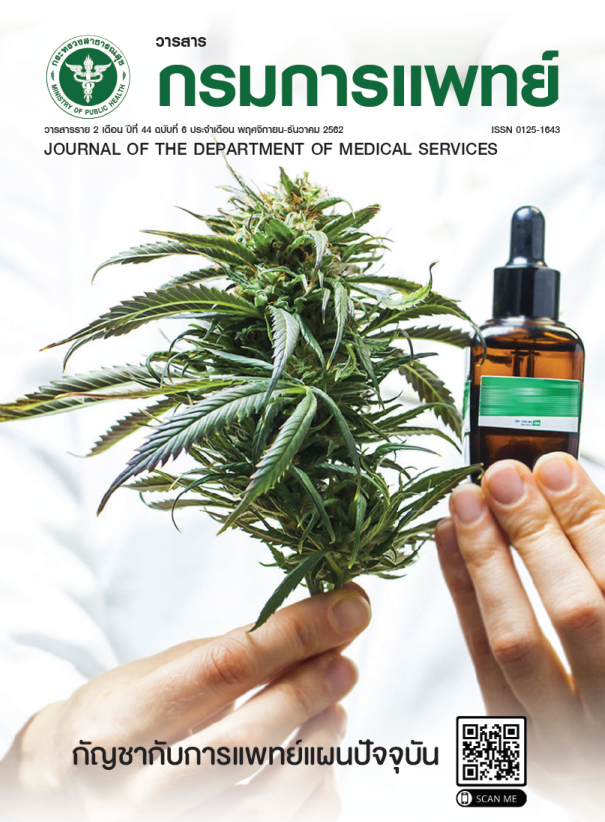Effect of Guava Leaf Extract Spray on Halitosis after Garlic Ingestion
Keywords:
Guava leaf extract, Halitosis, Garlic, Oral ChromaTMAbstract
This research aimed to investigate efficiency of guava leaf extract commercial spray on halitosis after garlic ingestion. Sixty subjects (11 male, 49 female, aged 20-37 years) with no systemic diseases, no smoking and alcohol, no removable denture, no fixed orthodontic appliances and no periodontal pocket > 5 mm were selected. The concentration levels of hydrogen sulfide, methyl mercaptan and dimethyl sulfide before garlic ingestion were measured (Tb) by OralChromaTM. After that, the subjects were separated into two groups; one used guava leaf extract spray and the other the NSS spray. Subjects were then given Nam-Neaung and 5g. of chopped garlic wrapped with dough sheet with sauce. Chewing continued for 1 minute followed by drinking water (200ml.). Halitosis self assessment was performed before and after garlic ingestion. Hydrogen sulfide, methyl mercaptan and dimethyl sulfide were measured (T1); subjects were sprayed using either the guava leaf or NSS spray. The levels of the three gases were measured (T2) again. To compare the concentration level of hydrogen sulfide, methyl mercaptan and dimethyl sulfide before-after using the guava leaf extract spray, Wilcoxon Signed Ranks test was analyzed. To compare the concentration levels of hydrogen sulfide, methyl mercaptan and dimethyl sulfide between guava leaf extract spray and NSS spray, Mann-Whitney U test was analyzed at 0.05 significance level. The result show that concentration level of dimethyl sulfide was significantly reduced (p=0.000), but that of hydrogen sulfide were not significantly reduced. In contrast, the level of methyl mercaptan was significantly increased after using guava leaf extract spray (p =0.029). Comparing between using the guava leaf extract spray and NSS spray, there were not significant differences in reducing the concentration level of hydrogen sulfide, methyl mercaptan and dimethyl sulfide (Mann-Whitney U prob = 0.333, 0.780 and 0.690). In conclusion, Guava leaf extract spray efficiently reduced hydrogen sulfide and dimethyl sulfide after garlic ingestion. However without significant difference when compared with the use of the NSS spray.
References
Pharmacognosy and Pharmaceutical Botany department and Thaksin herbal center, Faculty of Pharmaceutical Sciences, Prince of Songkla University. Herbal for primary health care. Bangkok: J Chareonkarnpim; 2008.
Ried K, Fakler P. Potential of garlic (Allium sativum) in lowering high blood pressure: mechanisms of action and clinical relevance. Integr Blood Press Control 2014;7:71-82.
Xiong XJ, Wang PQ, Li SJ, Li XK, Zhang YQ, Wang J. Garlic for hypertension: A systematic review and meta-analysis of randomized controlled trials. Phytomedicine 2015;22:352-61.
Wang HP, Yang J, Qin LQ, Yang XJ. Effect of garlic on blood pressure: a meta-analysis. J Clin Hypertens (Greenwich) 2015;17:223-31.
Schäfer G, Kaschula CH. The immunomodulation and anti-inflammatory effects of garlic organosulfur compounds in cancer chemo prevention. Anticancer Agents Med Chem 2014;14:233-40.
Bosy A. Oral malodor: philosophical and practical aspects. J Can Dent Assoc 1997;63:196-201.
Sanz M, Roldan S, Herrera D. Fundamentals of breath malodour. J Contemp Dent Pract 2001;2:1-17.
Quirynen M, Zhao H, van Steenberghe D. Review of the treatment strategies for oral malodour. Clin Oral Investig 2002;6:1-10.
Quirynen M. Management of oral malodour. J Clin Periodontol. 2003;30 Suppl 5:17-8.
Haydari M, Bardakci AG, Koldsland OC, Aass AM, Sandvik L, Preus HR. Comparing the effect of 0.06%, 0.12% and 0.2% Chlorhexidine on plaque, bleeding and side effects in an experimental gingivitis model: a parallel group, double masked randomized clinical trial. BMC Oral Health 2017;17:118.
Quirynen M, Zhao H, van Steenberghe D. Review of the treatment strategies for oral malodour. Clin Oral Investig 2002;6:1-10.
Negishi O, Negishi Y, Ozawa T. Effects of food materials on removal of Allium-specific volatile sulfur compounds. J Agric Food Chem 2002;50:3856-61.
Suarez F, Springfield J, Furne J, Levitt M. Differentiation of mouth versus gut as site of origin of odoriferous breath gases after garlic ingestion. Am J Physiol Gastrointest Liver Physiol 1999;276:G425-G30.
Laakso I, Seppanen-Laakso T, Hiltunen R, Muller B, Jansen H, Knobloch K. Volatile garlic odor components: gas phases and adsorbed exhaled air analysed by headspace gas chromatography-mass spectrometry. Planta Med 1989;55:257-61.
Geoghegan F, Wong RWK, Rabie ABM. Inhibitory effect of quercetin on periodontal pathogens in vitro. Phytother Res 2010;24:817-20.
Mirondo R, Barringer S. Deodorization of Garlic Breath by Foods, and the Role of Polyphenol Oxidase and Phenolic Compounds. J Food Sci 2016;81:C2425-c30.
Ravi K, Divyashree P. Psidium guajava: A review on its potential as an adjunct in treating periodontal disease. Pharmacogn Rev 2014;8:96-100.
Prabu GR, Gnanamani A, Sadulla S. Guaijaverin – a plant flavonoid as potential antiplaque agent against Streptococcus mutans. J. Appl. Microbiol 2006;101:487–95.
Van Steenberghe D, Rosenberg M. Bad Breath: A multidisciplinary approach: Leuven University Press; 1996.
Newman MG, Takei HH, Klokkevold PR, Carranza FA. Carranza’s Clinical Periodontology. 12nd ed. St. Louis, Missouri : Elsevier Saunders; 2015.
Campisi G, Musciotto A, Di Fede O, Di Marco V, Craxi A. Halitosis: could it be more than mere bad breath? Intern Emerg Med 2011;6:315-9.
Tangerman A, Winkel EG. Volatile Sulfur Compounds as The Cause of Bad Breath: A Review. Phosphorus, Sulfur, and Silicon and the Related Elements 2013;188:396-402.
Scully C, Greenman J. Halitology (breath odour: aetiopathogenesis and management). Oral Dis 2012;18:333-45.
Tangerman A, Winkel EG. Intra- and extra-oral halitosis: finding of a new form of extra-oral blood-borne halitosis caused by dimethyl sulphide. J Clin Periodontol 2007; 34:748-55.
Snel J, Burgering M, Smit B, Noordman W, Tangerman A, Winkel EG, et al. Volatile sulphur compounds in morning breath of human volunteers. Arch Oral Biol 2011;56:29-34.
Sirichompun C, Chareonvit S, Jarunamsiri K, Chearjaraswongs T. Efficiency of drinking water, chewing guava, or chewing cucumber on reduction of temporary halitosis after garlic ingestion. CU Dent J 2007;30:245-54.
Downloads
Published
How to Cite
Issue
Section
License
บทความที่ได้รับการตีพิมพ์เป็นลิขสิทธิ์ของกรมการแพทย์ กระทรวงสาธารณสุข
ข้อความและข้อคิดเห็นต่างๆ เป็นของผู้เขียนบทความ ไม่ใช่ความเห็นของกองบรรณาธิการหรือของวารสารกรมการแพทย์



